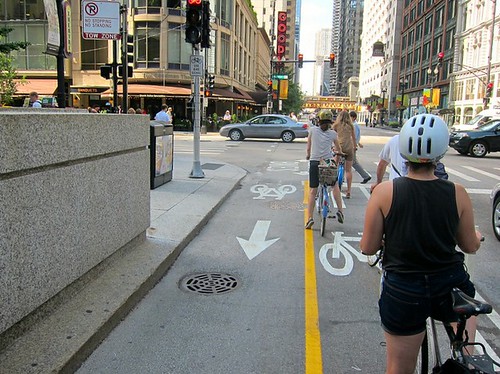It seems like every time the city proposes an innovative sustainable transportation project, there’s someone who attacks the plan as an irresponsible waste of money for our cash-strapped city. For example, Roger Romanelli and his Ashland-Western Coalition anti-bus rapid transit group have repeatedly argued that the CTA’s plan to build 16 miles of fast, reliable BRT on Ashland Avenue at a cost of $160 million is outrageously expensive. Other initiatives like Divvy bike-share, which cost $27.5 million for the first 400 stations, and the Dearborn protected lanes, which cost $450,000, have also come under fire from citizens and in the press as frivolous uses of taxpayer dollars.
Streetsblog Chicago contributor Shaun Jacobsen has brilliantly skewered these arguments on his blog Transitized with a graphic that illustrates how ridiculously cheap these initiatives are compared to highway construction. “Every time I’ve been to a community meeting, there’s always at least one person who wonders how we have money for bike lanes and new transit stops, but we don’t have money for police officers, the children, etc.,” Jacobsen writes. “Too often, it’s easy to get lost in the zeros and the -illions of dollars being spent on a project. What’s the difference between $55 and $56 million dollars, anyhow? One possible answer: 6.5 miles of new protected bike lanes.”
The Solar System-like diagram shows various projects as circles whose area reflects their relative costs. While the $3.4 billion Elgin-O’Hare Expressway and $2.5 billion Central Lake County Corridor (IL-53 Extension) appear as massive orbs, BRT and bike-share are relatively tiny dots, and the Dearborn PBL and the $150,000 Berteau Greenway are barely visible specks. Why is Romanelli, executive director the Randolph/Fulton Market Association, carping about the pricetag for the bus plan when its dot is dwarfed by the $475 million Circle Interchange Expansion? He didn’t bat an eyelash over that destructive, property-value-lowering project, also in his district.
Jacobsen says he’d also like to create an interactive graphic that depicts the relative cost of all types of regional transportation projects. “It’s important to put the numbers in perspective so we truly understand what we decide to invest in,” he writes. “The media can report various figures for large expressways, but the difference between a $1.1 billion highway and a $1.2 billion one could be a greenway in every neighborhood of the city.” I’m looking forward to re-posting Jacobsen’s chart the next time the anti-BRT crowd starts making noise about the relatively minor cost of a project that, unlike wildly expensive suburban highway boondoggles, will be money well-spent.





